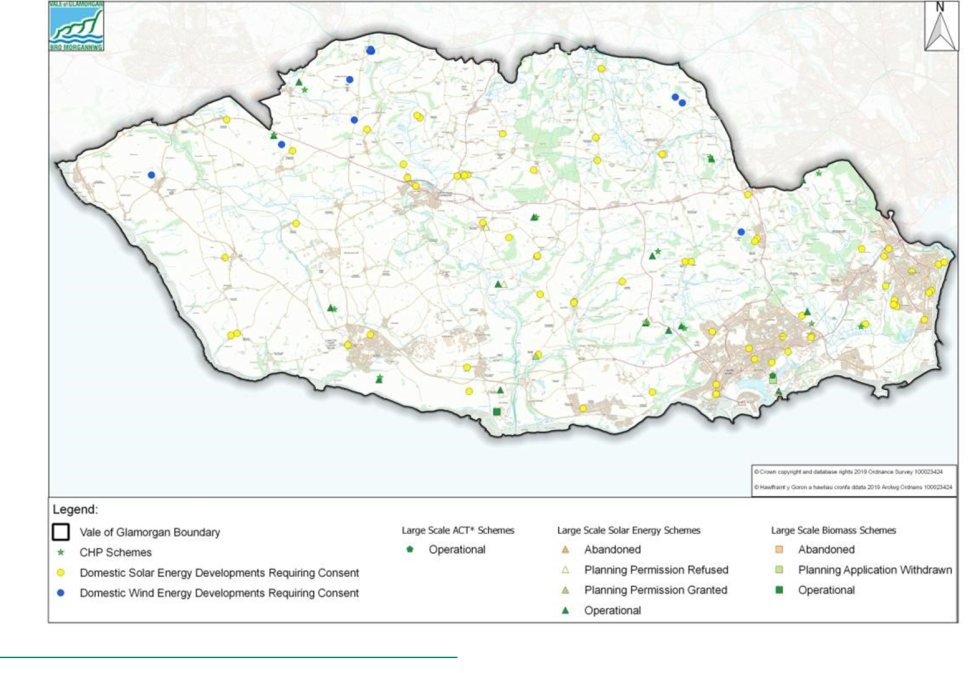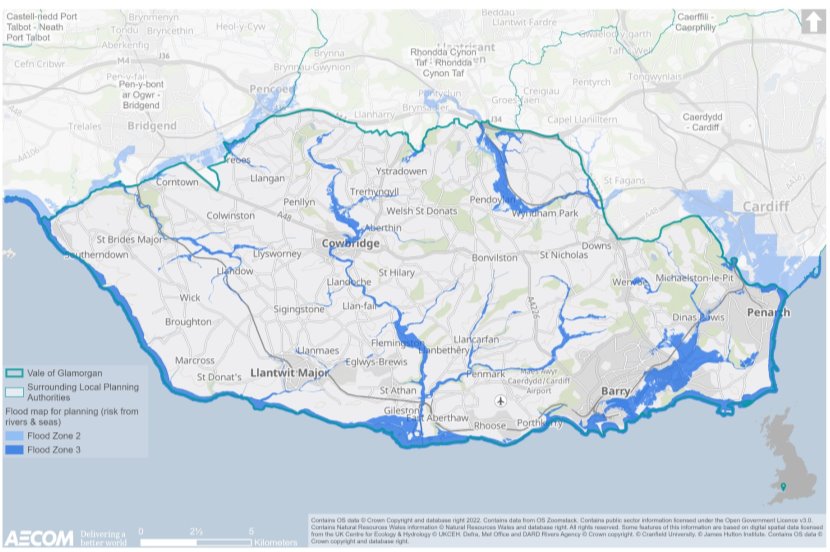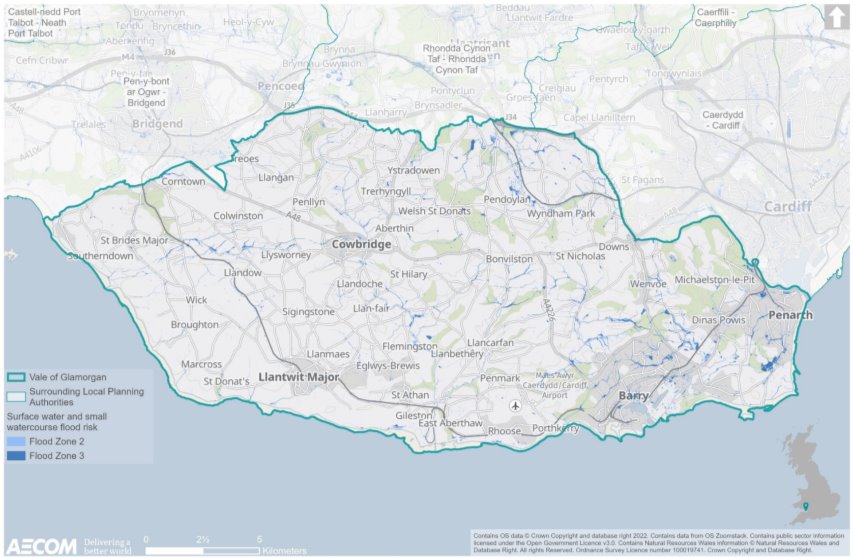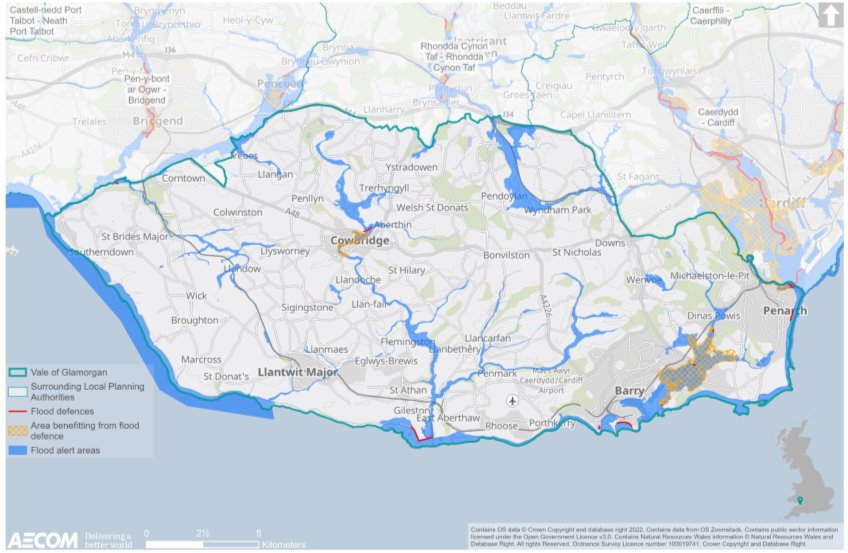Integrated Sustainability Appraisal (ISA) Scoping Report
6. Climate change (mitigation and adaptation)
6.1 This theme focuses on activities in the RLDP area that contribute to climate change and climate change mitigation, as well as the effects of climate change, including flood risk, and climate change adaptation.
Policy context
6.2 Table 6.1 presents the most relevant documents identified in the policy review for the purposes of the RLDP and ISA.
Table 6.1 Plans, policies and strategies reviewed in relation to climate change
Document title
Year of publication
2015
Technical Advice Note (TAN) 15: Development, flooding and coastal erosion
2021
2019
6.3 Key messages emerging from the review are summarised below:
- The Climate Change Act 2008 provides a framework at the UK level regarding the need to mitigate and adapt to climate change. The Act sets a legally binding target of reducing the UK's Green House Gas (GHG) emissions by 80% by 2050 compared with 1990 and requires a programme of rolling carbon budgets to be set to achieve this. The RLDP should set out policies and proposals to minimise environmental effects from new development and to promote use of renewable and low carbon technologies and minimising emissions of GHG emissions.
- Future Wales sets out the 20-year spatial framework for land use in Wales, providing a context for the provision of new infrastructure/ growth. Future Wales provides a framework at the Welsh level to respond to the need to mitigate and adapt to the effect of climate change, recognising the role of the planning system in leading the way in promoting and delivering a competitive, sustainable, decarbonised society. The framework therefore focuses on seeking to decarbonise key economic sectors, encouraging renewable and low carbon energy generation and enhancing the resilience of the natural environment. The SDP for South East Wales will also seek to address regional factors; recognising the potential for planning to shape places in ways that contribute to radical reductions in greenhouse gas emissions, and deliver long-term resilience; including through reuse, regeneration and conversion.
- National planning policy is set out in PPW which recognises that the planning system has a vital role to play in making development resilient to climate change, decarbonising society and developing a circular economy for the benefit of both the built and natural environment. PPW is supplemented by TANs, which together provide detailed planning policy and advice. Notably in relation to flooding, the general approach of PPW, supported by the TAN (TAN15 – Development, flooding and coastal erosion), is to advise caution in respect of new development in areas at high risk of flooding, by setting out a precautionary framework to guide planning decisions. The overarching aim of the precautionary framework is to direct new development away from those areas which are at high risk of flooding.
- The revised TAN15, initially published in 2021, will now take effect in 2023. Where any local authority will be undertaking a new Strategic Flood Consequences Assessment (SFCA), revised SFCAs must be in place by the end of November 2022, and will be the principal source of evidence to inform development plans' settlement strategies and site allocations in respect of flood risk, as well as locally specific flood risk policies.
- In line with the Flood and Water Management Act (2010), Welsh Government has produced its second national strategy on flood and coastal erosion risk management (FCERM) (October 2020). The strategy sets out how the Government intends to manage the risk and sets objectives and measures for all partners for the next ten years. Future LDPs will need to recognise the risk and provide a policy framework which looks to prevent exposure to risk which will be informed by the anticipated Wales Flood Map.
- When preparing the RLDP, the Council should consult with adjacent authorities and Natural Resources Wales and ensure that, as well as not being at risk itself, development does not increase the risk of flooding elsewhere.
- Prosperity for All: A Low Carbon Wales (2019): This Plan sets out the Welsh Government's approach to cutting emissions and increasing efficiency in a way that maximises wider benefits for Wales, ensuring a fairer and healthier society. It sets out policies and proposals that seek to directly reduce emissions and support the growth of the low carbon economy. Of relevance to the RDLP are targets and policies introduced in relation to:
- Energy.
- Transport.
- Buildings.
- Industry.
- Land Use, Land Use Change and Forestry.
- Agriculture; and
- Waste Management. - In December 2020, the Climate Change Committee published its progress report "Reducing Carbon Emissions in Wales". This is the first report on Wales' progress towards meeting its emission reduction targets, as required under Article 45 of the Environment (Wales) Act 2016.
- In February 2021, the Welsh Government announced its commitment to reaching net zero emissions by 2050 through the publication of The Climate Change (Wales) Regulations 2021 which came into force on the 19th March 2021. The Regulations establish the legal commitment to net zero carbon emissions by 2050.
- The new Regulations form part of the wider statutory framework for the reduction of emissions in Wales, set out in Part 2 of the Environment (Wales) Act 2016, amending the previous set targets for 2030 and 2040 targets from 45% and 67% to 63% and 89% respectively.
- The Cardiff Capital Region and City Deal seeks to promote strong, connected and sustainable growth throughout the region, supporting Welsh Government's objectives in relation to infrastructure and climate change. The deal aims to encourage investment, adaptation, and innovation within the ten local authorities and other key partners in its boundaries. Other local policies and plans will positively contribute towards tackling the causes of climate change and the need to deal with the consequences of climate change.
- The Cardiff Capital Region Energy Strategy[104] has been developed with support from regional stakeholders, including local authorities. The overall objective being to develop a pathway identifying key interventions to deliver on the region's ambitions for decarbonising its energy system.
- The Cardiff Capital Region (CCR) has purchased Aberthaw Power Station, to develop and reposition it as an exemplar for green energy production in the region. A master plan for the site is currently being prepared which will seek to support the redevelopment of the site to deliver a range of renewable and green energy projects such as battery storage, a zero-carbon manufacturing cluster, green hydrogen production facilities and a green energy innovation centre to promote innovation, growth, knowledge and community interaction with the zero-carbon future of Wales.
- Project Zero Challenge Plan (2021) is the Vale of Glamorgan Council's response to the climate change emergency. Project Zero brings together the wide range of work and opportunities available to tackle the climate emergency, reduce the Council's carbon emissions to net zero by 2030 and encourage others to make positive changes. The strategy highlights the role the replacement LDP plays in contributing to the climate change commitment through for example securing planning contributions towards sustainable transport schemes and through implementation of policies that encourage renewable energy. The Council's Renewable Energy Report identified opportunities in the Vale of Glamorgan for a range of renewable energy schemes, particularly from standalone solar PV developments, small clusters of wind energy potential, biomass, and micro generation including Building Integrated Renewables.
- Specifically, the Vale of Glamorgan Renewable Energy SPG has been produced to support and add detail to the adopted LDP. It is intended to provide clear and precise guidance to assist homeowners, landowners, developers and other interested parties involved in the planning process on how to fully consider renewable energy in development proposals. Furthermore, the guidance seeks to ensure the benefits of renewable energy development are balanced against economic, social and amenity impacts on communities as well as the environmental impacts which include biodiversity and preserving the visual landscape to 10MW.
Baseline summary
Climate emergency
6.4 In July 2019 the Vale of Glamorgan Council joined with Welsh Government and other Councils across the UK in declaring a global 'climate emergency'. The Council made a commitment to:[105]
- Reduce the Council's carbon emissions to net zero before the Welsh Government target of 2030 and support the implementation of the Welsh Government's new Low Carbon Delivery Plan.
- Make representations to the Welsh and UK Governments, as appropriate, to provide the necessary powers, resources and technical support to Local Authorities in Wales to help them successfully meet the 2030 target.
- Continue to work with partners across the region.
- Work with local stakeholders including Councillors, residents, young people, businesses, and other relevant parties to develop a strategy in line with a target of net zero emissions by 2030 and explore ways to maximise local benefits of these actions in other sectors such as employment, health, agriculture, transport and the economy.
Mitigation
6.5 While there is limited information available at a local authority level on greenhouse gas emissions, the latest statistical summary from the Department for Business, Energy & Industrial Strategy (2019) (based on data up to 2017), indicates that Wales' CO2 per capita emissions as a whole are higher than the rest of the UK regions and stand at 7.9 tonnes of CO2 per person. This is due to Wales having the highest CO2 per capita emission from the Industrial and Commercial sector (4.4t) reflecting its higher level of industrial installations. UK wide, total greenhouse gas emissions have decreased by a further 2% between 2017 and 2018 bring a total reduction since 1990 of 43%.[106]
6.6 The Vale of Glamorgan's emissions largely reflect the significant industry, agriculture and airport present. The graph below shows the CO2 emissions for the Vale of Glamorgan 2004-2018, as measured by the Department for Business, Energy and Industrial Strategy.[107] Figure 6.1 demonstrates that the industry sector has historically been, and remains, the largest contributing sector with regards to carbon dioxide. It also shows that for all sectors emissions have seen a significant decrease since 2004, although figures appear to be levelling off between 2016 and 2018.
6.7 Notably, decommissioned Aberthaw Power Station is set to be converted into a green energy hub after being purchased by Cardiff Capital Region (CCR)[108]. As such, it is likely that CO2 emissions from industry will decrease in the future.
6.8 It is also worth noting that Cardiff Airport is likely a significant contributor to transport emissions in the Vale.
Figure 6.1 Vale of Glamorgan carbon dioxide emissions by year[109]
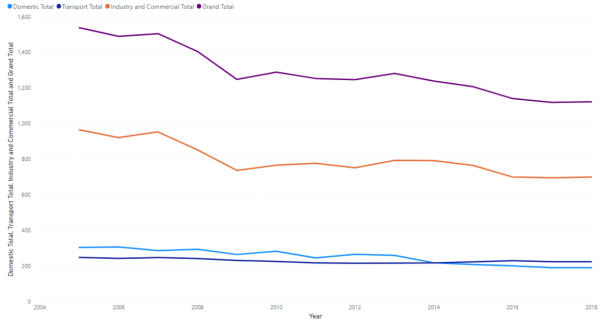
Renewable energy
6.9 Despite emission levels shown in Figure 6.1 above, data shows that the LDP target of granting planning permissions sufficient to meet 10.6% (56.68 GWh) of projected electricity demand through renewable energy sources by 2020 has been met.[110]
6.10 The Vale of Glamorgan Council has been implementing a range of projects that benefit the environment and reduce carbon emissions (see Project Zero Challenge Plan). Ongoing commitments to emissions reductions include:[111]
- The Council purchase 100% of electricity from renewable sources and has granted planning permission to several solar farms.
- The Council have undertaken over 100 energy saving projects across council buildings including switching old inefficient lighting to LED lighting and the introduction of better energy controls.
- The Council have begun switching heating from gas to electricity by installing a Ground Source Heat pump at Cadoxton House in Barry and an Air Source Heat pump at BSC2 (the Engine Room) in Barry. These sites have seen significant improvements in energy consumption and there are plans for further installations.
- The Council have installed Solar panels on 14 buildings with a combined capacity of 480 KW. All systems are sized appropriately to match demand at the buildings on which they are mounted.
- 68% of the Council's street lighting has been converted to LED with plans to increase this to 92%.
6.11 As mentioned above, decommissioned Aberthaw Power Station is also set to be converted into a green energy hub.
6.12 Figure 6.2 identifies all the known renewable energy and low carbon schemes which either have planning permission or are operational as of 2019 in the Vale of Glamorgan.[112] As to be expected, domestic solar schemes are the most prevalent, with schemes located throughout the Vale; while wind energy schemes are more limited in number, and located predominately to the north of the authority.
Figure 6.2 Existing and Proposed Low and Zero Carbon Energy Schemes[113]
Electric vehicles
6.13 Electric vehicles have a significant role to play in securing a greener future on the roads. The transport sector accounts for 17% of greenhouse gas emissions in Wales, and only 0.17% of vehicles used in Wales are electric.[114]
6.14 In line with national commitments, Vale of Glamorgan Council are delivering EV infrastructure and supporting the shift away from diesel vehicles throughout the authority. Notably:
- The Council's Parking Standards SPG (2019) encourages the provision of electric vehicle charging points and within non-residential developments seek to secure 10% of the total required parking spaces to provide electric vehicle charging point infrastructure, whilst also encourage similar provision within residential developments.
- Electric vehicle charging stations have been installed at selected school sites.
- Since March 2019 at least 10% of car parking spaces on non-residential developments are required to have electric vehicle charging points infrastructure.
- The Council is developing a network of Electric Vehicle Charging Points and is undertaking a feasibility study to investigate the options for providing safe and accessible electric vehicle charging capability at off and on street residential properties within the Vale of Glamorgan.
- The Council are supporting projects which promote alternatively fuelled vehicles; and
- The Council has begun to replace its existing fleet of diesel- powered pool cars with EVs.
Adaptation
6.15 Climate change is predicted to have effects relating to short-term changes to weather patterns as well as longer-term shifts in climatic trends. Weather patterns are predicted to see an increase in extreme weather events, including intense rainfall, heating, drought and cold snaps. Changes to climate are likely to lead to mean reductions in rainfall alongside mean increases in temperatures. It is also important to consider the seasonality of these shifts, with winters in the UK likely to be warmer and wetter and summers expected to be warmer and drier. Another consequence of climate change is rising sea levels, an issue which is exacerbated by storm surges which can lead to coastal flooding and erosion. Climate change adaptation refers to the actions taken to manage impacts of climate change by reducing vulnerability and exposure to its harmful effects, as well as exploiting any potential benefits.
Flood risk
6.16 The Vale of Glamorgan Local Flood Risk Management Strategy (LFRMS) (2013) focuses on 'local flood risk', defined as flooding caused by surface runoff, groundwater and ordinary watercourses (streams, ditches etc).[115] This type of flooding was the cause of most of the damage of the local floods of 1998, 2000 and 2007 and need to be taken as seriously as flooding from main rivers or the coast. Since 2007 the Vale of Glamorgan has experienced further flooding and extreme weather, affecting most of the authority due to the widespread nature and duration of events.[116] More recently, in December 2020, significant flooding occurred in Dinas Powys and Sully. The Council subsequently undertook formal Section 19 flood investigations in relation to this flood event and the relevant reports are available on the Council's website via this link.
6.17 Main river flooding accounts for the majority of all recorded flood events in the Vale of Glamorgan. As shown in Figure 6.3 below, fluvial flood risk extends throughout the Vale, mainly following the river corridors, and overlapping with settlements to some extent. The communities at highest risk from flooding are Cowbridge, Dinas Powys and parts of Barry, including Barry Docks and Atlantic Trading Estate. Llantwit Major is also at risk.
6.18 The LFRMS highlights that surface water flooding is much more difficult to quantify, particularly given that many incidents are often masked by the impact of main river flooding, or go unreported.[117] However, based on anecdotal evidence and improved recording of recent incidents, surface water flooding is believed to occur fairly frequently within the Vale of Glamorgan. Figure 6.4 shows that surface water flood risk exists throughout the wider RDLP area, extending through Cowbridge, Llysworney, and north of Pendoylan. The areas at greatest risk of surface water flooding throughout the Vale appear to be focussed around the southeast, including parts of Barry and Penarth.
6.19 The LFRMS also notes that localised groundwater flooding is reported to have occurred in Ewenny Village, St Brides Major, East Monkton, Rhoose and Barry.[118]
Flood alert areas and flood defences
6.20 Figure 6.5 below shows areas in the Vale that benefit from flood defences that protect against flooding from Rivers and the Sea. These are located in Cowbridge and to the northeast of Barry, coinciding with flood alert areas. A Flood Alleviation Scheme (FAS) has reduced the level of flood risk within the main urban settlements of Cowbridge and Llanblethian. Elsewhere, informal defences provide protection where individual properties are at risk.[119]
6.21 The areas shown benefit from different levels of flood protection, and this is recognised in the risk classification shown in the Flood Risk Assessment Wales (FRAW) map.[120] It is noted that this is not property specific and shows the benefit for a general area. However, Figure 6.5 does also show specific flood defences that have been built, coinciding with flood defence areas, in addition to being located along the eastern and southern RDLP area boundary.
6.22 Notable recent Flood and Coastal Erosion Risk Management (FCERM) schemes include Boverton, Coldbrook and Llanmaes flood alleviation works[121].
Green infrastructure
6.23 Natural solutions to reducing flood risk can come in the form of green infrastructure, including tree cover. Permeable surfaces provided by greenspace help to reduce surface water runoff, which in turn helps to reduce flood risk. Trees provide interception, reducing the volume of water reaching the ground during rainfall events, helping to reduce flood risk. In this sense, it is important to look at the levels of green infrastructure and its management within urban areas, including the soil resource, path networks, urban woodlands and other green infrastructure aimed at enhancing the quality and accessibility of the local environment. Note that rural areas are generally open countryside which are less likely to have issues relating to surface water runoff.
6.24 Green and open space is vast throughout the Vale, as shown in Figure 4.1 and discussed in Chapter 4 above. However, the areas of green and open space which are in direct Council control represent a small percentage, highlighting the important role of private landowners in contributing towards mitigating climate change and the sustainable management of green infrastructure.
6.25 Despite the above, the Council can still implement effective measures, which has been proven by recent tree planting schemes such as that set to take place in Barry. Specifically, this scheme plans to prevent flooding in Barry by planting more trees and reducing the amount of concrete pavement[122].
6.26 In terms of relevant mitigation opportunities undertaken by the Council, monitoring has shown that since July 2018 the Vale has secured a replanting ratio of 2:1 for the removal of trees with a preservation order (TPO) or trees in a conservation area (TCA) This is in accordance with the Trees, Woodlands, Hedgerows and Development Supplementary Planning Guidance.[123]
Future baseline
6.27 New development could potentially increase flood risk through factors such as changing surface and ground water flows, loss of mature vegetation, damaging soils, overloading existing inputs to the drainage and wastewater networks or increasing the number of residents exposed to areas of existing flood risk and potential elevated flood risks in the future. However, the surface water related flood risk would be mitigated by the Sustainable Drainage approval process.
6.28 Climatic and weather pattern changes towards higher mean temperatures and extreme heating events are likely to be seen in the future, this can be expected to have more pronounced effects upon urban areas and in particular vulnerable populations within these areas. This is likely to necessitate the pursuit of opportunities to design cooling solutions into development, such as shading by retaining and planning of trees and increased green infrastructure and ventilation.
6.29 National and international policy and agreements have begun to show a more urgent stance in relation to approaches designed to combat and adapt to the effects of climate change. If this trajectory continues then it may be likely that a greater release of funding will be available for local schemes to adapt to the effects of climate change.
6.30 The policy agreements and urgency with which the matter of climate change is being focused upon is likely to increase over time. This will be expected to lead to policies which restrict the use of fossil fuel emitting activities and support energy efficiency measures, helping to drive down CO2 emissions.
6.31 It is considered that opportunities for renewable and low energy generation will further increase over time. This is anticipated to be across a range of sources, as well as from sources enabled through the development of new technologies. As discussed above, this is currently being taken advantage of throughout the Vale, for example with many operational large scale energy schemes in place.
Key issues
6.32 The context review and baseline information informed the identification of several key issues (problems and opportunities):
- In support the implementation of the Welsh Government's new Low Carbon Delivery Plan, there is a need to decarbonise across all sectors of society (including the economy, energy, infrastructure, lifestyles), with further need to take measures to reduce the levels of carbon in the atmosphere. Energy reduction and efficiency measures are being explored/ implemented throughout the Vale in line with the Project Zero Challenge Plan, with many operational large scale energy schemes in place.
- The need to ensure that existing natural resources are managed and protected in recognition of the significant role they have in providing natural solutions for mitigating the impact of climate change as well as supporting a wealth of biodiversity and improving wellbeing.
- Planning must play a key role in ensuring that communities and infrastructure are resilient to the negative effects of climate change, by avoiding risk in the first instance and seeking to mitigate risk if options are unavoidable (e.g., by utilising green infrastructure). In this respect, it is recognised that the adopted LDP target of granting planning permissions sufficient to meet 10.6% (56.68 GWh) of projected electricity demand through renewable energy sources by 2020 has been met.[124]
- Principal sources of flood risk within the Vale are from surface water and fluvial flood risk, the latter primarily along river corridors which pose a risk to some settlements. Coastal flooding is also a risk to some existing residential and employment areas notably parts of Barry Docks and Atlantic Trading Estate lie within high flood risk areas.
- Although overall emissions in the Vale have decreased over time, CO2 emissions data from 2016 to 2018 appear to be levelling off for all emission sources. It is however recognised that the situation may have changed since 2018, particularly given the Council's commitment to net zero by 2030 and strategies, projects, etc. implemented to help address this target. Notably, climate change has a knock-on effect on biodiversity, which is extremely sensitive to changes in the natural environment, including temperature, rainfall, humidity and wind speed. In this respect, it will be important that the relationship between these two SEA topics, especially in relation to the distinct climate / biodiversity in the Vale, is highlighted.
ISA objectives
6.33 Considering the key issues discussed above, it is proposed that the ISA should include the following objective and assessment questions:
ISA objectives
Assessment questions – will the policy/proposal help to:
Support the resilience of Vale of Glamorgan to the potential effects of climate change, including flooding from fluvial, coastal and surface water sources.
- Avoid development in areas at risk of flooding, considering the likely future effects of climate change?
- Increase resilience of the built and natural environment to the effects of climate change particularly in areas where coastal and fluvial flooding is identified?
- Ensure that the potential risks associated with climate change are considered in new development in the plan area?
- Protect, improve and extend green infrastructure networks in the plan area to support climate change adaptation?
- Utilise green infrastructure to sustainably manage water run-off, reducing surface water runoff, whilst creating opportunities for habitat creation, tree planting and open spaces?
- Minimise flood risk for key infrastructures, such as transport and power?
Reduce Vale of Glamorgan's contribution to climate change from activities which result in greenhouse gas emissions and contribute to meeting the Council's target of net zero.
- Increase the number of new developments meeting or exceeding sustainable design criteria?
- Reduce energy consumption from non-renewable sources?
- Generate energy from low or zero carbon sources?
- Reduce the need to travel or the number of journeys made?
- Promote the use of sustainable modes of transport, including walking, cycling and public transport?
- Ensure rural development does not contribute towards further increases in high energy use and unstainable travel?
[104] Cardiff Capital Region (2022): 'Cardiff Capital Region's green energy plans for Aberthaw Power Station set to create thousands of jobs', [online] available to access via this link
[105] Vale of Glamorgan Council (2021): 'Project Zero Challenge Plan 2021 – 2030', [online] available to access via this link
[106] Final UK greenhouse gas emissions national statistics from the Department for Business, Energy & Industrial Strategy (2020 figures)
[107] Ibid.
[108] New Civil Engineer (2022): 'Decommissioned Welsh power station to be converted into £36M green energy hub', [online] available to access via this link
[109] Ibid.
[110] Ibid.
[111] Ibid.
[112] Vale of Glamorgan Council (2019) Renewable Energy SPG
[113] Vale of Glamorgan Council (2019) Renewable Energy SPG
[114] Welsh Government (2021): 'Electric Vehicle Charging Strategy for Wales', [online] available to access via this link
[115] Vale of Glamorgan Council (2013): 'Local Flood Risk Management Strategy', [online] available to access via this link
[116] Vale of Glamorgan Council (no date): 'Community Flood Plan and Extreme Weather Guidance', [online] available to access via this link
[117] Ibid.
[118] Environment Agency (January 2012): 'Ogmore to Tawe CFMP Summary Report'
[119] Capital Symonds (2013): 'Vale of Glamorgan Local Flood Risk Management Strategy Volume 2 Strategic Environmental Assessment Report', [online] available to access via this link
[120] Ibid.
[121] Vale of Glamorgan (no date): 'Flood and Coastal Erosion Risk Management', [online] available to access via this link
[122] Barry Nub News (2020): 'The £192k Plan to Prevent Flooding in Barry with More Trees and Less Concrete', [online] available to access via this link
[123] Vale of Glamorgan Council (2021): 'Vale of Glamorgan Council declares nature emergency', [online] available to access via this link
[124] Ibid.


